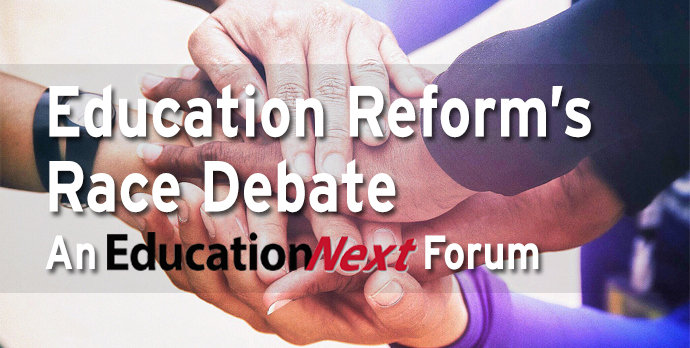Note: This is part of a forum on Education Reform’s Race Debate.
In the plays of Bertolt Brecht, actors spoke directly to audience members. Some called out stage directions, and others used cards to tell the audience members what was to come. In breaking theater’s elusive “fourth wall,” Brecht insisted that he didn’t want to destroy theater; rather, he wanted to refashion it for new social uses.
 We see a similar evolution in education reform today. Reformers of color, many of whom have supported the movement for decades, have decided to more aggressively tell mostly white leadership that a traditional reticence to discuss issues of race, class, and power can no longer be the movement’s modus operandi. Over the past year, the blogosphere has lit up with thoughtful commentary on this from Chris Stewart, Marilyn Anderson Rhames, and others. And EdLoc, launched by leaders of color across the country, is charting an inclusive third way to advance change in the polarized reform debate.
We see a similar evolution in education reform today. Reformers of color, many of whom have supported the movement for decades, have decided to more aggressively tell mostly white leadership that a traditional reticence to discuss issues of race, class, and power can no longer be the movement’s modus operandi. Over the past year, the blogosphere has lit up with thoughtful commentary on this from Chris Stewart, Marilyn Anderson Rhames, and others. And EdLoc, launched by leaders of color across the country, is charting an inclusive third way to advance change in the polarized reform debate.
Education reformers should pay close attention.
To date, we can count a multitude of policy wins—better data, stronger accountability systems, and a move toward more rigorous academic standards—along with a universal acceptance that we must aim to close gaps in achievement and opportunity. We should applaud these successes. But we’ve failed to learn important lessons along the way.
First, movements aren’t led by policies, they’re led by people—namely, the people most affected by the changes they are advocating for. We can’t afford to continue advocating on behalf of the students, educators, and families we serve. We must work with them. Low-income communities and communities of color have had a front row seat to the decades-long failures of our education systems. They have critical insights and opinions, and deserve the right to inform and set the agenda. The failure to do this has left reformers looking elitist at best, carpet bagging at worst.
Second, we must remember that the fight for education reform has always been a fight for racial justice. As civil rights icon Julian Bond said, “Violence is black children going to school for 12 years and receiving 6 years’ worth of education.” We can’t tackle educational change without recognizing systemic and structural racism. We must own our implicit biases and recognize how privilege and power play themselves out in our decisions and the movement we’ve built. Though uncomfortable to some, this type of dialogue, when done right, comes with more rewards than risks, strengthening partnerships rather than dismantling them.
Groups like Black Lives Matter and the N.A.A.C.P. are critiquing the work of reform. Both have begun to question the merits of wholesale charter-school growth and its implications for students of color, for example. Last year, my own organization published Black Minds Matter, a call to action to reverse the century-long squandering of California’s black talent.
Third, equity must be at the center of an education reform agenda—as an action, not a word. The data clearly paint the need to focus on students of color and low-income students: nationally, only 73 percent of black students, 76 percent of Latino students, and 75 percent of low-income students graduate, compared to 87 percent of white students and 89 percent of middle- and high-income students. These gaps will take several decades to close if we continue at our current rate of progress.
Simply saying “equity” doesn’t mean we’ve truly prioritized it. That entails shifting power and resources. Equity means education leaders committing to close, not merely narrow, achievement and opportunity gaps and fighting for the resources and evidence-based strategies to do so. Equity means philanthropic leaders reassessing who and what they fund. Equity means going back to the drawing board and rethinking the composition of our own boards and executive leadership teams.
Education reform organizations, when hiring, should also redefine who is considered America’s best and brightest. It’s problematic that we proclaim to understand educational inequities, and then perpetuate them by seeking to promote only Ivy League graduates. If we want to grow as a movement, it will take an intentional commitment to diversify our ranks at every level. The quicker we learn this, the better.
And fourth, education reform must retain its collection of strange bedfellows. Only a dynamic coalition of leaders from every corner of our nation can finally dismantle the harmful structural inequities that plague students every day. We may not agree on all the issues, but if Van Jones and Newt Gingrich can find common ground, we can too. Recognizing race, class, power, and privilege isn’t a ploy to drive out white liberals or even social conservatives; rather, it is an attempt to help the movement mature.
As a progressive, I can truly say I’ve grown up in the education reform movement. Either we learn from our mistakes or start over again. While I believe it’s easier to do the former, I’m not opposed to the latter. For folks who’ve committed their lives to ensure that we finally provide the disenfranchised an opportunity to thrive in this generation, we realize that time is short. Hopefully, this inflection point provides a welcome moment of reflection—and an urgent course correction.
Ryan J. Smith is executive director of The Education Trust–West and an Annie E. Casey Children and Family Fellow.


